(Written by William)
Let’s face it, LEGO makes a lot of sets, and LEGO is expensive. LEGO also retires sets after a period of time. All of this means that we may not be able to afford everything we want when available, and by the time we are ready to buy, the set of our dreams could be out of production. Or you may learn about an old set just now, but it has been retired years ago. So what to do? This is what we will explore today. 🙂
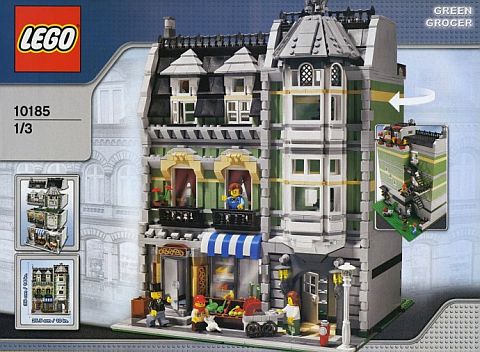
We basically have three options when a LEGO set that we want has been retired already. We can always pretend the set doesn’t exist and put it far out of our minds. The next option is take advantage of the secondary market like eBay, BrickLink, etc. You will likely find the set you are looking for, but unless you stumble upon an amazing deal, you will have to pay significantly more than the original price. This could mean having to wait longer to save up enough money for that retired set, and in the meantime you may also miss out on newer sets that you want. This can turn into a vicious pattern of always playing catch up and ending up spending far more than intended.
Then there’s the method where you build the set from your own spare LEGO elements that you may or may not need to substitute with buying individual parts, based on the size of your current collection. This last method of piecing together retired LEGO sets instead of buying them as a whole, can work out as more economical in situations where the price of the retired set has skyrocketed. Some people also enjoy having a long-term project reconstructing an old LEGO set. Whatever the reason, I’d like to discuss some of the tips and issues I’ve had with this way of collecting. Perhaps my example can save you a headache or two.
➡ GETTING INSTRUCTIONS FOR RETIRED LEGO SETS
The first step in putting together an old LEGO set is making sure you can get your hands on the instructions. Some people are happy to just download the instructions to their computer from an online source, others buy the original instruction booklets on BrickLink or eBay. If the set is really valuable, the instruction booklets will be expensive also, so you may just want to stay with downloadable instructions. You can find instructions for all recently released LEGO sets on LEGO’s own website. And there are also other websites that catalog the instructions for older LEGO sets. No matter which way you go, it helps to have the exact LEGO set number to find the instruction you want. The instructions are the key piece of putting together any LEGO set, so before you do anything else you need to make sure you get this.
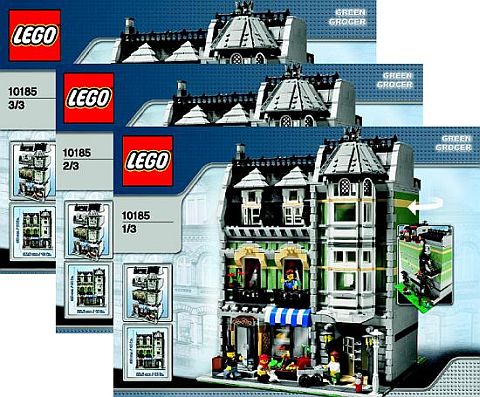
➡ RESEARCHING PRICES FOR RETIRED LEGO SETS
Now that the LEGO set is picked out and you have the instructions, the next step is to do a bit of research. Start by finding out what the going rate for the set is on the secondary market. My personal go-tos are BrickLink and eBay. The price-guide on these websites will give you a gauge that you can use to decide which makes more sense: buy the set as a whole, or piece it together yourself. For example, I wanted to build the #10185 LEGO Modular Green Grocer that has been retired years ago. The piece-count for this sets is 2352 pieces, and the price back in 2008 was $150. Now on the secondary market I found the lowest prices around the mid $700s with a good majority at the $800 mark – this is for used sets. New condition sets go well over a $1,000. I felt there was plenty of room to find some savings.
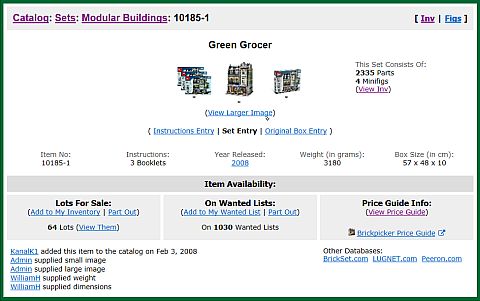
While you are researching prices, keep in mind that if you plan to stretch out building a set over months or years, equaling the going rate of the set is not a bad thing. However even if you are doing things the long way, you should never spend more than the going rate. Your personal preferences may differ, but essentially you are giving up more LEGO pieces when you spend more. Once your budget is established, you can then determine if the project is worth your time. You know what you like to spend and what you are capable of affording. This early stage is a final check to figure out whether or not you will move forward with the project.
➡ RESEARCHING PARTS FOR RETIRED LEGO SETS
Now I know I said the project can move forward, however I like to do one more step just so there are no unpleasant surprises. This step involves taking a look at the parts in a set. For this I use the BrickLink. I click Catalog at the BrickLink website and then find the set by either browsing the categories or entering the set number in the search box. Once I find its page, I click on the View Inventory link. Seeing all the parts in the set laid out on one page lets me look for expensive and/or unusual elements. There are no prices immediately listed on this page and I doubt anyone wants to click through and see prices for each part, but I look for three main criteria: rare part design, rare part color, and large quantity.
Rare part design is typically specialized pieces. Minifigures are the biggest rare part design in most sets due to unique prints. Other candidates are special doors/windows, animals, hoses and printed elements. At least these are the parts that have been rare for me and didn’t have in my collection. You should have a general knowledge of what is in your own spare parts collection, and also look for things that appear to be unique to the set.
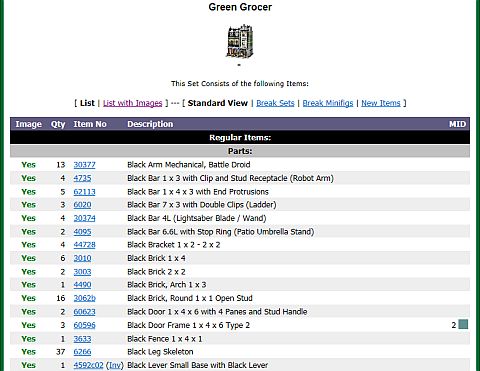
Next we look at rare colors. You may not realize this, but when we are in control of everything we buy we tend to gravitate towards colors we like. Therefore, your collection of spare LEGO parts will likely have more or less the same colors. So when you look through the parts-list for a set you are trying to put together, pay attention to colors you know you don’t have much quantity. My project involving the #10185 LEGO Modular Green Grocer has a tremendous amount of sand-green parts that I didn’t have in my collection.
Finally, look for high quantities of a piece in the parts-list. My rule of thumb is to look at anything that uses double digits – so 10 or more. Many times I can disregard small pieces like 1×1 bricks that I know I have plenty of. Once you identify parts you are concerned about, click on that part’s number, select the right color, and see what they are selling for. It is important to keep an eye on the country the seller is from since shipping will eat at your budget faster than anything else. It was during this time I discovered that I not only needed fifty 1×8 sand-green bricks, but that they were each about $2.50. After $125 total for that, I discovered I also needed fifty-six 1×2 sand-green bricks with a groove. They were just as expensive. Not great for my budget. And even after being able to identify some of these obvious expensive pieces, you can still run into rare parts you might not have expected. In the case of the #10185 LEGO Modular Green Grocer, there was a blue arch piece that came in very few other sets, thus it was expensive.
➡ GETTING ORGANIZED
So now that we’re at the stage where we have a budget and we are convinced that this is a good idea that won’t break the bank, it’s time to get organized. For this I recommend using some of the tools on BrickLink. You can part out the set into a wanted list by clicking the Part Out link on the set’s page. Here we can choose various options like do we want minifigures listed as fully assembled, do we want to be notified when new items get listed, do we want boxes and instruction-manuals in our list, etc. I also like to make the minimum quantity wanted the same as what is on the list. That way I know how much is needed without having to look up the set every time.
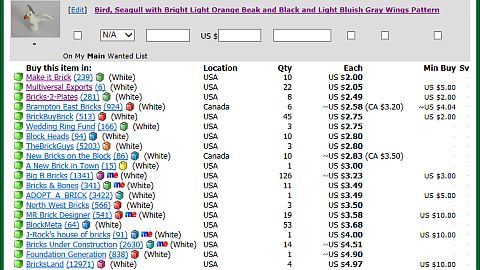
I also like to create a completely new Wanted List for each project and leave my default main Wanted List open for miscellaneous wants. Once the list is populated, you may want to take a moment to compare the list to the set’s inventory page. When I put together my Wanted List for the #10195 LEGO Modular Market Street, to my surprise, a few parts were left off because they had a MID (Matching Part ID). Turns out that in this instance the system did not know which part to add, so it did not add either. For those who are confused, you are not alone. MID parts are parts that look and act exactly how you might need them in a set. There are small differences, but nothing that matters when it comes to the set you are working on. For example, a bus that uses white train windows can use the ones that have or don’t have shutter-holes. The parts look nearly identical except for this very minor difference. However, a set like the #10190 LEGO Modular Market Street uses shutters in the white train windows so only one type will work. Essentially, you need to make sure that the system did not leave off any parts. It is very annoying when you get around to building to find that you are missing a single part that is not terribly rare, but you just don’t have it.
➡ SORTING & PULLING PHASE
If you are like me, and have a lot of loose parts in your own collection that you want to use it putting together a set, the process can be daunting. So it is a good idea to first have your own LEGO collection sorted and stored property. Thanks to my wife’s help, our LEGO elements are sorted first by color then by part type. So a great way for me to start pulling parts for the project is to change the filter options on the BrickLink Wanted List to show by color rather than piece type. This allows me to work through several colors, then have the option of stopping at any time.
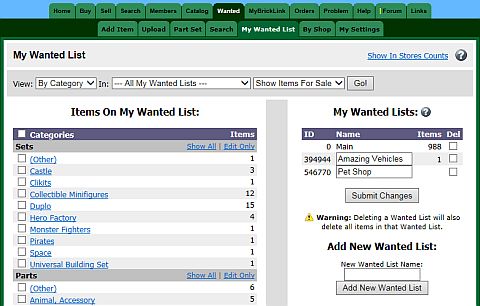
In order to hold the pieces I pull for the project, I typically use a sturdy zip-lock style bag. I actually found the two gallon variety works amazingly well for large sets. As I go through the list, I’m either clicking the delete box when I have all the pieces or I’m moving the quantity I still need into the comment box from the minimum quantity wanted. The reason for this move has to do with how BrickLink functions. If you keep the amount only in the minimum quantity wanted box, it only shows that element if that quantity is reached in a particular store. So even if the store has some of the pieces you need, it will not show up if you have the minimum quantity box filled with a higher number. Unlike the minimum quantity box, the comment box is only a brief note. So no matter how many pieces a store has, their inventory will show up in your search results. And the nice thing is that your note will also show right under where you would indicate how much of each piece you want.
This step will be the most tedious process of the whole project, However a Wanted List is a crucial step. It allows for fast and easy searches of stores and can enable some quick filtering. Additionally, there are LEGO fans out there who have made free software available that takes care of all the BrickLink searching for you in regards to best combination of prices and shipping fees. For more information on this check out the BrickLink forums.
➡ TIPS FOR SHOPPING FOR LEGO PARTS
As I mentioned above, there is some software available to make the BrickLink shopping experience more automatic, but I personally like shopping without the aid of a program that will do everything for me. Sure I might not be getting the very best price, but I can support some of my BrickLink favorite sellers. At any rate, I like to start any project by pulling up some of the rarest, most expensive parts I need to purchase. I do this by selecting those pieces individually and finding the cheapest prices on BrickLink for them.
Once I have several shop pages open (for rare parts it should be no more than 1-5), I select to show all items each store has from my wanted list, then compare what they have and their prices. I will do this in part to get the best deal and to fulfill a good portion of my wanted list, and also to get over the seller’s minimum order value (if they have one). This allows me to pay a few cents more on a common element while saving dollars on a truly rare one.
I also keep an eye on elements listed as used. They often are the cheapest variety but they can also be the most discolored. One time I even received a piece with a sticker I needed to remove. Usually the pieces you don’t want used are ones that are entirely decorative like a printed element or window-glass. The problem with glass is not how clean it is but how well it fits in a frame. If the nubs are worn down too much they can easily fall out. As for discolorations, white is your biggest issue. It’s the one piece that is very noticeable when discolored. Keep this in mind if what you want is a pristine looking final model.
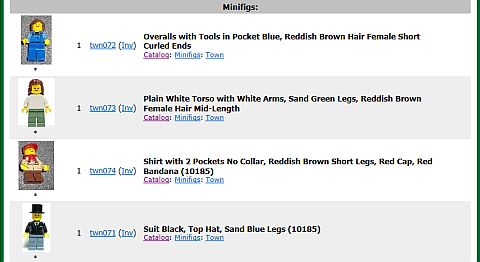
Finally, when it comes to minifigures, look them up both completely assembled as well as in parts. Often a very rare minifigure that may go for $20 assembled can be bought for less than half that price in parts. I typically create a second Wanted List for this very purpose to make searching easier. Also, some LEGO fans who piece together sets don’t even care about the minifigs. For example if you are setting up a street with multiples of the same LEGO Modular Building, you may only need one set of the minifigures.
➡ WORKING AROUND PROBLEM PARTS
Sometimes you may run into the issue with a piece that is just not convenient to get. Or it is possible that facing $3 per piece is bit hard to swallow. Thankfully there are a number of work-around solutions to problems like these. The first is finding if there is a part with a Matching ID (MID). If you go to the parts inventory of the set on BrickLink, parts with a MID have a mark in a column to the far right. This means that if you go to the very bottom of the inventory you can find parts that are slightly different (like they have hollow studs instead of filled or they have a few extra notches), but essentially they will look and act identical.
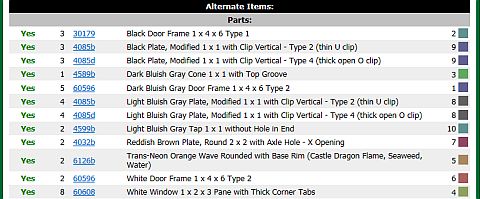
If this fails you can consider your own swap options. This may include using smaller pieces in the case of replacing a large brick or using a more modern window that looks very similar and will only be noticed by those who are intimate with the set. Finally, you may try changing the color. The option of changing the color is a big one. If you are considering doing it, you want to look at all the other elements in the set that share that color. For example, I had the option of using sand-blue instead of sand-green in the #10185 LEGO Modular Green Grocer. It would have definitely been cheaper in certain areas, but there were pieces made in sand-green that weren’t made in sand-blue, so it became a less attractive option. Keep in mind that a full replacement is not always necessary. A good builder can fit in color-swaps very subtly. You will ultimately need to be the judge of how complete or modified the end model needs to be.
➡ OTHER TIPS ON BUILDING RETIRED LEGO SETS
Every person works best with their own system, so these final tips are offered as suggestions to try in an effort to help. They are not meant to be definitive in any sense of the word. You may implement the ones you like and disregard the ones that don’t work for you.
Printed parts-lists for a LEGO project are a great way to have an easy reference-guide to how things are progressing with your project. The list can be kept with the project and may make a useful guide when ordering. The printout can take any form you want, including Excel sheets or a printer-friendly version of the set inventory.
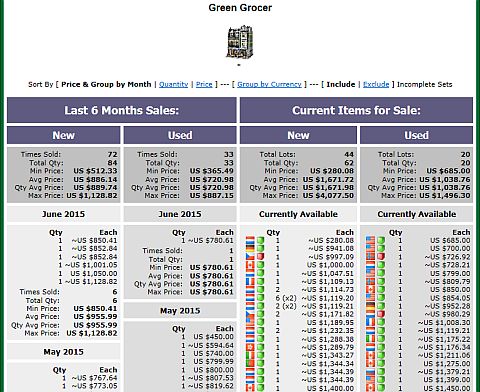
Another tip is to create a buying guide Wanted List on BrickLink. This is a list you can alter as soon as you commit to purchasing an item, but you won’t adjust your main list until the item is actually received. Sometimes sellers mix up parts, or forget to include them in your order. With this system in place you can continue purchasing without the fear of duplication and still leave a way to make sure you haven’t missed any elements.
Sort the incoming LEGO elements for the project in a way you like to build. Sure, you could just shove the pieces all in one big bag as they arrive from different sellers, however if you take the time to sort the elements in a way that you enjoy building, then when it comes time to put the set together, things are a lot easier. A couple of sorting methods are either by color or by piece category. I’ll often make broader categories like all blues or all bricks – whether they are modified or not. The added advantage of this method is that if you have to double check if you got a part already it is easier to find the answer. For large projects with thousands of pieces this can be very helpful.
If you are patient and believe a LEGO piece is extremely expensive at current prices, use the notification features of BrickLink. Having notifications for dozens of pieces is annoying because you will get so many emails a day, but having the notifications set for a small handful of very rare pieces is very helpful as you will be notified as soon as a seller lists them.

Hopefully this overview will get you organized enough to start on that dream LEGO set you never thought would be possible to get. It can be a long road to see the fruits of your work, but when all is done you have the added accomplishment of knowing how much work went into the project. To date I’ve assembled two LEGO Modular Buildings I missed out on when they were originally released, and I’m currently working on a third. I’ve also completed a handful of old LEGO Castle sets.
What do you think? Have you considered piecing together retired LEGO sets? Or have you done it already? What was your experience? Are there any other tips I haven’t mentioned here that you would like to share? What retired LEGO set would you really like to get? Feel free to share in the comment section below! 😉
And you might also like to check out the following related posts:












This is really interesting. I guess the research is the most important part to see if it makes sense to reconstruct a set vs. just buying it on the secondary market. Personally I wouldn’t mind substituting parts when they are too expensive or hard to find. Lego sets are really just an idea to start with anyway.
Yes, if you are not a collector substituting the most expensive elements is a good option.
I always go with #1. I have never bought a retired set, although I have bid on them, only to not get it because i don’t want to pay $100 for a 100 piece set.
I think this is mainly a problem with series like the Modulars. Relatively few people paid attention to the firs couple of the buildings, but when it became clear that it was going to be a series, people wanted to collect all of them, including the ones that were now retired. There are also new people who are just getting into LEGO due to the popularity of The LEGO Movie who missed out on some great sets. They can do as you mention, and just focus on the newest sets, but if it is a series like the Modulars and they really would like to have a full collection, their only option is to shell out $$$s or to piece together the set themselves.
Sometimes what i do is buy all the parts in the set and buy the instructions. The total is cheaper than the set 60% of the time.
I don’t really think I will ever sell my Lego. Even if I am in the dark ages.
I sometimes download instructions just to learn some interesting building techniques. It is a good way to learn. 🙂
Great article !! I am currently awaiting for a lot of Bricklink orders to to be delivered, covering the building-from-spare-parts of… 2.5 modulars ^^” Those are Cafe Corner, right-half of Market Street and Fire Brigade (I already had a lot of Dark Red bricks and tiles so it was a no-brainer !). Thus, having spent a lot of time and money in the process, I can confirm absolutely everything I just read in this article 😉 From Wanted Lists tips to problems with parts, I went through all of it, so it’s very pleasing and reassuring to know that other people have experienced that.
Let me add one tip to your “Working around problem parts” paragraph that I learned way to late in the process : systematically download the instructions so that, when a hard-to-find-part related problem arises, you can locate in the instructions where the part is used, so you decide if you work around it or not.
Also, the Architecture series is a great source of models to build from spare parts. The best example is Marina Bay Sands : I managed to build it for approx. $80, whereas it goes for $800 in the market. And it was delighful 😀
That’s a really good suggestion about working with problem parts, especially with large sets like the modulars. Thanks for sharing! And yes, the Marina Bay Sends set is a very nice build with interesting techniques, so are many of the other LEGO Architecture sets. 🙂
This a great article that I’m bookmarking. I suddenly wished I had gotten the Town Hall modular and found the current going price rather ghastly. I’m gonna have to use these suggestions to see if it’s more affordable to just part it together, even if it ends up in a different main color than the original. Thanks!
The Town Hall is a very sweet set. I really like the colors. I fully furnished and customized mine on the inside, so it is fun from that perspective too. If I remember correctly all of the parts are pretty standard. However if you consider parting it together it is probably better doing it earlier than later as more want to do the same.
Having built numerous sets this way I fully agree and adopt a similar method myself.
I’m less bothered by substitutions though so if necessary I’ll swap a full colour for another etc. Fortunately this makes it vastly cheaper.
The other bonus I have is I dont collect the modulars. Having missed too many I ran the numbers and immediately ruled it out.
My long term project is the Taj but that one will likely take me several years to assemble the parts….
Great article!
Having a list of parts needed in a spreadsheet is definitely helpful when buying all of the parts for a retired set. Early this year I decided that I had to have the LEGO Taj Mahal, and checked eBay and several other sites for prices. I definitely couldn’t afford to buy it new (or even used for that matter), and I had very few spare parts, so I decided to buy all of the parts. I made a list of all of the parts I needed, along with pictures, and organized it by color. It really helped to see the progress I was making on acquiring all of the parts. Luckily I was able to get all of the parts within about two months. I also substituted a few pieces with different colors, due to price, but they were pieces that would not be seen when the set was fully put together. It turned out very nice. Organization is definitely important!
Hey, I had the same thought as you. The set it way too expensive to buy and I want to actually have it assembled, not for collecting. Would you be able to share with me how you were able to get all the pieces and obtain the instructions?
You can get all the pieces you need by just building up a Wanted List on BrickLink and seeing which shops have the best prices and quantity. You can also get the instruction booklets on BrickLink, or just get the PDF version online.
One problem with downloading instructions is that often the resolution is so poor that they’re practically useless. All of the black and dark pieces fade into a blur…
Yeah, I have experienced that as well. Even from LEGO’s own website. It is worth checking how much printed instructions are on BrickLink. Although for exclusives they can be expensive, for most sets they are just a few cents.
I think it might be better for newer sets, but for certain years, the overall quality of the scans was very bad.
Yes, I know what you mean. I have seen that as well. Sometimes adjusting my screen’s resolution does help with darker colors.
I just parted out and built the Death Star II (10143), and one thing that has helped me was downloading the LDD file for the set. When you can see the 3D model and virtually take it apart, you can see what color something should be. It also helps to show what pieces will be hidden, which allow you to substitute the color if there is a huge price difference.
Dennis, that’s a really good strategy. Where do you get the LDD version?
The EuroBricks forums have a thread with LDDs for almost every LEGO set:
http://www.eurobricks.com/forum/index.php?showtopic=41226
That’s awesome! An incredible resource for sure! Thanks for sharing!
What about rebrickable.com? This can store your entire collection, tell you what pieces you have missing from any set and create a shopping list at specific brick link or brick owl vendors. Super handy!
Woah thanks for sharing that awesome website!
I definitely like the additional suggestions. Having instructions on had is one more way to stress how vital research is in projects like these.
A special should be noted about substituting inner foundational pieces. Rare pieces go right out the window when it comes to these. Many times the designers add these to give fans unique pieces to play with, but if they are never seen then you’ll spend a lot for very little return.
I’ve definitely heard of rebrick but have never used it personally. I’m not sure how it would work for me since I’m both a builder and collector and therefore have two catagories of LEGO pieces. One is strictly to stay with the sets and everything else is building material. However, it is the perfect solution for those who may not have a seperation and can get more milage out of their collection.
A brief note on some of the program names you guys might want to look for. Brickstore or brickstock are programs that fans can use to make custom wanted lists. The program will even let you spit out an .xml file for mass upload and allow you to share your work with friends.
Brickwizard is a program that works off of Brickstore and it can help do all the leg work in trying to find the best prices on bricklink. The only downside is that it is not as flexible when and if you want to make substitutions.
One great source for special parts should not be swept under the rug: Lego itself!
You can use Lego’s “Bricks and Pieces” service (in the support section of their homepage) to buy spare and replacement parts for specific sets or specific parts (if you know their number).
But while they are great for specific parts, you should only use this service for a few rare parts you can’t find anywhere else. In my experience BrickLink prices are usually 30-50% below the offical Lego prices, or even more for very common pieces.
Yes, that’s a good resource as well. I also found their pricing much higher than BL and their selection is limited, but as you mentioned for rare pieces and expensive pieces it is worth to check. An issue with Bricks and Pieces though that is good to keep in mind is that their shipping time can take weeks as they ship directly from Denmark. So if you are in the USA, Canada, Australia, etc. it can take weeks. But yes, they should definitely be a resource to at least check out for comparison shopping.
If find the challenges of putting together a set fun in itself. I’m currently putting together 10231 Space Shuttle Explorer, 10197 Fire Station, 8480 Technic Space Shuttle and 6395 Victory Raceway (which I desperately wanted, but never owned as a kid). I could easily buy them on eBay or elsewhere, but the challenge of this is far more interesting.
A couple of tips I’ve picked up – watch postage fees! When putting together an order I make sure I keep the postage cost per part to a minimum. I start with the uncommon parts a seller has, then using the cheapest/common parts I need, bulk up the order so that the number of parts makes the postage per part tiny.
It helps also to attempt multiple sets at once, again maximising your orders and minimising fees.
I also buy bulk sales from eBay, that offer local collection to keep costs low, and are usually an attic clearance etc. I sell any sets I can make from these, which helps pay for the new ones. Often these sets have parts missing, which I replace during my parts orders, again helping me keep postage costs down. I then sort out any parts that I need, and the remainder get sold on brickowl.
Megan, thanks for sharing! Yes, postage fees can really add up if you don’t manage your wanted list right. Good suggestion about buying parts for several projects at the same time. Have fun with piecing together those awesome sets! 🙂
REALITY it’s location, location, location! What has all of our parents said to use at least a 1000 times on your life span???? “If I only kept that box it came in.” Yeah you have the the first two in the series bUT do you have the boxes for them?
Hm… yeah, for large sets like this it is a good idea to keep the boxes, but it is not necessary. If you bought the set for yourself and have no intention of selling it, there is no reason to keep the box (unless you really like it and want to keep it). If you do plan to sell it, it doesn’t make a huge difference in the resale price of a used set to have or not have the box. Most people will throw it away anyway.
Thanks for these tips for buying LEGO sets. It’s good to know there are sites where I can go to compare prices. I would like my son to have his own LEGO collection, so I should do this to find the best price for a cool set for him to put together.
Fantastic article and very helpful. Thank you 🙂
You’re very welcome. 🙂